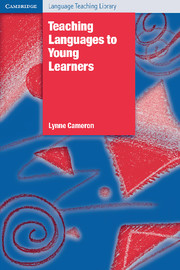Book contents
- Frontmatter
- Contents
- Preface
- Acknowledgements
- 1 Children learning a foreign language
- 2 Learning language through tasks and activities
- 3 Learning the spoken language
- 4 Learning words
- 5 Learning grammar
- 6 Learning literacy skills
- 7 Learning through stories
- 8 Theme-based teaching and learning
- 9 Language choice and language learning
- 10 Assessment and language learning
- 11 Issues around teaching children a foreign language
- References
- Index
9 - Language choice and language learning
Published online by Cambridge University Press: 05 May 2010
- Frontmatter
- Contents
- Preface
- Acknowledgements
- 1 Children learning a foreign language
- 2 Learning language through tasks and activities
- 3 Learning the spoken language
- 4 Learning words
- 5 Learning grammar
- 6 Learning literacy skills
- 7 Learning through stories
- 8 Theme-based teaching and learning
- 9 Language choice and language learning
- 10 Assessment and language learning
- 11 Issues around teaching children a foreign language
- References
- Index
Summary
Introduction
Language choice and language learning
This chapter considers issues around the uses of the foreign and first languages in the classroom. It looks at evidence from real classrooms and how we might interpret what has been found. In many situations, teachers are required to use only the foreign language in their language lessons, or they feel that they ought to. In practice, research and anecdotal evidence suggests that most teachers who share their pupils' mother tongue, use a mixture of the foreign language and the mother tongue. We will examine this evidence in some detail to look for patterns in the types of activities that each language is used for, and to see how teachers and pupils switch between languages in the course of activities. When we have a clearer picture of patterns of language choice, we can then develop the principle of ‘deliberate language choice’, in which choice is guided by the overarching goal of fostering the children's foreign language learning. This enables us to move away from the simple but impractical guideline ‘use only the target language’ to more subtle and helpful principles for language choice: ‘use as much of the target language as possible, and ensure that use of first language supports the children's language learning’.
The rest of the chapter will be devoted to exploring how those principles translate into action. Choosing to use more of the foreign language may mean that extra work is required to support children's understanding. If pupils are required to use the foreign language, then we know that this makes a greater demand on them than just understanding and that, again, appropriate support will be needed.
- Type
- Chapter
- Information
- Teaching Languages to Young Learners , pp. 199 - 213Publisher: Cambridge University PressPrint publication year: 2001

